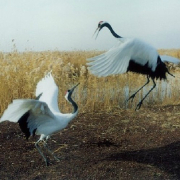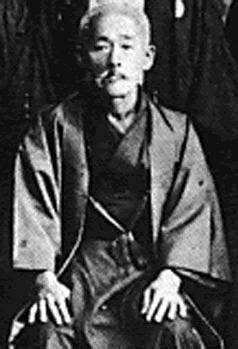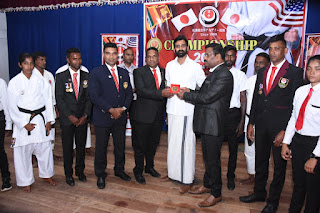The hunt for Lu-Lu Ko, Chinese teacher of GoJu Ryu’s founder Master Higaonna Kanryo.
Translated by Shaun Hogan from:
日本空手道与福建南拳的历史渊源
http://blog.sina.com.cn/s/blog_69b37d930100jzv7.html
(2010-08-03 10:08:56)
Author: 休闲 XueXian
[Translator’s forward notes: The hunt for
Goju Ryu Master Higaonna Kanryo’s Chinese teacher. Many texts show
that the original Chinese master of GoJu Ryu’s founder Higaonna was
named Ru-Ru Ko (ルールーコ)Since this is not a Chinese name, the founder’s
name becomes difficult to trace. In 1987, the Fujian Wushu Association
and the Okinawan Goju Ryu Karate Do Association met to research the
originator’s name. They concluded that Higaonna Kanryo’s master was
named: Xie Zongxian his birth name – Xie RuRu “RuRu” was sort of a nickname. – RuRu Ko is
an honorific title where “Ko” is the Fujian pronunciation of “Ge”, Big
Brother. In other words, “RuRu Ko” works out to “RuRu Big brother.”]
Translation of the Mr. XueXian’s Chinese Blog Post:
Karate-do uses both hands
and feet, combining offense and defense, attacking the opponent with
various techniques such as kicking, hitting, and striking, using fists,
palms, fingers, elbows, knees, and legs to make various attacks.
Karate-do is a martial art that embodies the intensity of fighting, and
does not use any equipment to engage in self-defense while minimizing
harm to the opponent. It has been popularized all over the world. Where
does Japanese karate-do originate? This is a topic jointly studied by
the All Japan Karate Federation and the Fujian Wushu Association.
1. Fujian was the birthplace of Japanese karate.
Advertisements
Report this ad
According
to historical records, in the Ming Dynasty, the Ryukyu Islands
(Okinawa) were still a relatively poor and backward island country. The
backwardness of Ryukyu (Okinawa) was due to the ineffective, closed
sailing trade business that blocked exchanges between the Ryukyu Kingdom
and neighboring countries, resulting in a negative economic situation.
In the historically verifiable five years of Hongwu (1372), Zhu
Yuanzhang sent personnel to Ryukyu. And the King of Ryukyu, Zhongshan
Haodu sent his brother Tai to pay tribute to the Chinese capital, thus
starting friendly exchanges between RyuKyu and China. After sending 36
families from Fujian to Ryukyu, Okinawa’s economic outlook was greatly
improved. The “Thirty-six Fujian families” were people who were skilled
at boat building, sailing, and trade. They facilitated tribute
payments to and from China, built commercial industries and agriculture,
and set up payment and trade systems back and forth with Chinese ports.
(ref: Minghuiyao Vol. 77).
They were all residents of Shenzhou Hekou
(the river mouth) in Fujian (now in the South Park area). The Ming
Dynasty rulers made these people good at sailing. Transferred to Okinawa
to serve the people of Ryukyu, on the one hand, to improve their
sailing skills and trading forays, the 36 Families reversed RyuKyu’s
economic backwardness. On the other hand, the 36 Families “changed the
culture and customs behind the era, to make the culture and religions
of both sources flourish together. (“Zhongshan Shipu” Vol. 3, 44,
“Ryukyu Historical Materials Series” “). Since then, the 36 Families who
moved from the Shenzhou HeKou have not only become the main role of
Ryukyu’s foreign relations activities, they also brought advanced
science and culture to Ryukyu, as well as Chinese traditional martial
arts.
In the fifteenth year of Emperor Xianzong
of the Ming Dynasty (1480), some Ryukyu people went to Fujian for a
special assignment to learn martial arts. After five or six years, they
returned to Ryukyu (now Okinawa) and combined Fujian Nanquan (Southern
Fist) with the Ryukyu masters. The combination of ethnic fighting
techniques formed a unique boxing technique called “hand”
(transliteration of Te). This was the germination of karate due to the
exchanges between China and Ryukyu and cultural exchanges and commercial
trade.
Fujian had a variety of fighting styles,
especially those from the loyal survivors of the late Ming Dynasty who
fled to Okinawa, and strengthened Hua “Te” fighting skills, laying the
embryonic form of “ToDe” translated as “Tang Hand”, the meaning of
Chinese fighting, to show that they would not forget their roots.
Beginning in 1927, the Ryukyu Education
Department organized the “Okinawa Karate Symposium” in Naha to study and
develop the issue of “Te”. At the meeting, it was decided to change the
“TouDe” (Chinese Hand) to “Karate” (Empty Hand). At that time, due to
the environmental relations of the trading ports, the martial arts
practice in Shuri, Naha, and Boshou was very popular, and talented
people came out in large numbers to study and teach. Among the genres of
Ryukyu karate, the most famous are “Shuri-Te” and “Naha-te.” They were
created by Itsosu Anko and Higaonna Kanryo
respectively. The technical characteristics of these two schools were
different and each had its own strengths, but both belonged to the
traditional Nanquan Southern Fist faction in Fuzhou, Fujian Province.
2. Karate and the style of Fujian Nanquan
Okinawa’s GoJu style karate belongs to the
“Naha Te”, created by the Miyagi Chosun, the young disciple of Higaonna
Kanryo. The training methods, movement structure, movement names, style
characteristics and technical principles of “Naha Hand” and Fujian
Yongchun White Crane Fist. The katas and routines are roughly the same.
Analyzing from the training method and movement structure: the
rigid-flexible flow routine training requires the “three wars strategy”
as the basis, and then gradually developed to the advanced routine.
Report this ad
In
addition to standing up and running, Fujian Yongchun White Crane style”
is to practice the “three wars strategy”. One of the expressions of the
“three wars strategy” were the “three positives”. The first positive
emphasizes “head upright, body upright, and horse upright”. The second
positive is the “three changes”. Requiring “hand change, body change,
step change”. These two statements are indispensable in the training of
white crane boxing.
“Three fundamentals” is the training basis
of White Crane. As long as you master the “Three-Fundamentals” well,
you can talk about the “Three Changes”. Only when you have a good grasp
of the “Three Changes” can you change freely in the application and win
with your hands. Analyzed from the name of the kata, the Japanese
karate’s Superimpai (108″ hands) kata is the same as the wording of
Fujian White Crane’s 108 hands kata.
A few years ago, when the Japanese karate
delegation visited Fuzhou, they also brought “White Crane Kata Sheet”.
They said: “My ancestors were trained according to this kata sheet and
passed down from generation to generation.” “White Crane Boxing Book”
was the manuscript passed down from Fujian, and it is the same as the
book of boxing kept by Fujian’s elderly martial artists. .
Analyzed from the style characteristics
and technical principles: The rigid-flexible flow routine style requires
a strong launch, a steady footwork, and the breathing and luck of the
“Three Wars Strategy”. Trained into strong, rigid and flexible muscles
and bones. The Fuzhou White Crane fist strike is a “stroke of muscles
and bones in a string of energy”, the two are the same, and they are
just like the GoJu Ryu “single (double) fingering gun fingering” attack
method is jab, and the most vicious is eye jab. It is the same as the
“Golden Gunner” technique of White Crane Boxing; the technique of “Wind
Eye Boxing” punches and drills specifically to hit the opponent’s
acupoints, the eyebrows and the throat are centered, and the single
chicken boxing in Minghe Boxing ( He Fengyan) has the same technique;
the palm technique of the “hand knife” specializes in cutting the
opponent’s neck, back, and intercostal space.
- The creator of karate, GoJu Ryu was in Fujian
On May 23, 1987, the Japanese Okinawa GoJu
Ryu Karate ancestor-seeking group came to Fuzhou City, Fujian Province
to find roots and visit their ancestors, looking for the generous
Chinese master of Higaonna Kanryo. Under the responsibility of Comrade
Lin Weigong, the editorial board of local chronicles, they cooperated
with the Fujian provincial military.
During the investigation period, an
extensive investigation was carried out on all the more famous masters
in Fuzhou, and finally Xie Ruru, the first generation master of the
Fujian “Minghe Clicking Crane Boxing”, was identified as the generous
master of Higaonna Kanryo. Chief researcher Lin Weigong said in the
summary: Higaonna’s teacher’s real name should be Ruru, surname Xie,
clan character Zongxiang, born on July 31, 1852 (June 15, Qing Dynasty
Xianfeng second year) in Daibian Village, Zhanxiang Township, Changle
County.
At the age of 13, Xie Zongxiang (RuRu)
moved to Fuzhou with his father Xie Zunzhi because of a fire at his home
at the age of 13, and he also studied with his father’s friend Pan Yu
to practice boxing. At the age of 23, Xie RuRu was exquisite in martial
arts and became famous. . Ruru inherited Pan Yuba’s crane fist, combined
with her own characteristics to consider a set of rigid and soft
techniques, and created a fist that emphasizes the “three wars”. With
the sound of clucking like a crane, it was named “Minghe Fist”. Xie
RuRu became ” The master of Minghe Fist.
Report this ad
On
September 16, 1989, relevant experts once again gave a further argument
on whether Xie Ruru (ZongXiang) was indeed the Chinese martial arts
master of Higaonna Kanryo, the originator of Japanese Okinawan GoJu
Ryu., learned in Fuzhou.
And on June 9, 1990, in the southwest
corner of the Fuzhou New Sports Center, a solemn black marble “revealing
monument” stood A memorial to the great amount of Chinese master Xie
Zongxiang (Xie RuRu). This is a clear proof of the influence of the
traditional Chinese and Japanese martial arts circles.
(Translators’ note: the name LuLu Ko ルールーコ
often attributed to Higaonna’s Chinese master is an honorific title:
LuLu is his name. Ko means “big brother” an honorific title.)
4. The origin of Uechi Ryu Karate in Fuzhou
The style of another Japanese genre Uechi
Ryu Karate-do is similar to the tiger-shaped boxing style passed by
Master. Zhou Zihe of Fuzhou. Its hand shape, technique, step shape,
footwork, lvocalization, and forceful methods all maintain tiger-shaped
boxing characteristics.
On March 29, 1981, an Okinawa martial arts
delegation headed by Takahikari Yuki visited Fuzhou and asked for help
in finding the origin of Uechi-Ryu Karate-do with origins from the
Chinese master Mr. Zhou Zihe.
The Fujian Provincial Wushu Association
commissioned Mr. Wei Qiqi to organize an investigation. The results
found that: Mr. Zhou Zihe was born in 1874 in Zhiri Village, Nanyu,
Fuzhou City, Fujian Province. He was a master of martial arts since he
was a child. , Good at iron sand palm, specializing in hard work. Later,
he traveled to and from Fuzhou City and often set up a pavilion to
teach apprentices at the Gulou Marshal Temple. In 1897, the Japanese
student Uechi Kanbun came to Fuzhou to learn martial arts with Mr. Zhou
Zihe, and returned to Japan 13 years later.
In order to promote the popularization of
Japanese martial arts, combined with the characteristics of Okinawa,
Master Uechi created the Uechi Ryu Karate-do style.
In 1985, relevant experts from Fujian
Province sent the book “Tiger Shape Boxing” passed down by Mr. Zhou Zihe
to the Uechi-Ryu Karate-do Headquarters. They happily said: “In the
past, the Uechi Ryu karate-do headquarters participated in all-Japan
competitions under the banner of Zhou Zihe, but they didn’t see their
true colors. They were dubious. Now the first page of the book is a
portrait of our ancestors. It’s really amazing.” “Crouching Tiger
Heroes” recorded by Fujian Audiovisual Publishing House in 1990 is the
testimony of preaching a generation of tiger-shaped boxing master Zhou
Zihe to teach Okinawan martial artists..
Summary
In recent years, Fuzhou City, Fujian
Province has had frequent exchanges with Okinawa martial arts circles in
Japan. So far, Fuzhou City has also built the “Naha Friendship History
Exhibition Hall, Ryukyu Hall” and so on. In June 1995, in order to
commemorate the fifth anniversary of the establishment of the “Revealing
Monument”, a Japanese Martial Arts delegation of more than 50 people
came to hold a martial arts conference with the martial arts community
in Fujian Province. The mutual exchanges between the two countries are
of great benefit to martial arts becoming an Olympic event as soon as
possible!





































